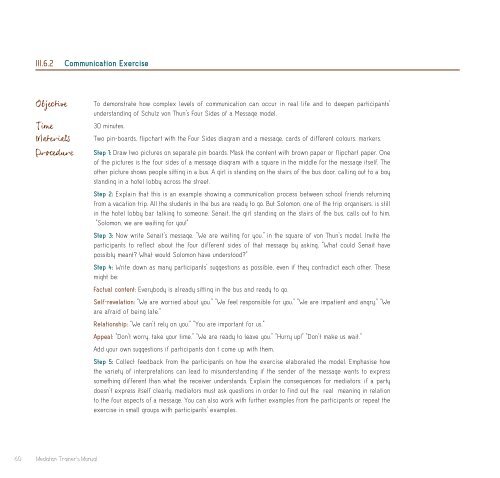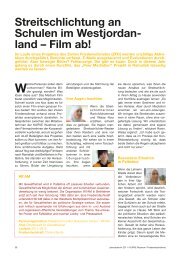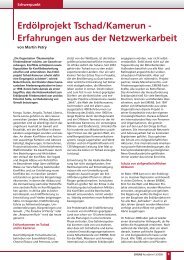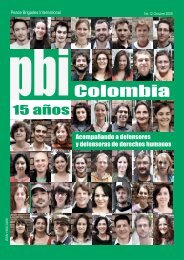Merging Ethiopian Wise-Counsel Mediation and Facilitative ...
Merging Ethiopian Wise-Counsel Mediation and Facilitative ...
Merging Ethiopian Wise-Counsel Mediation and Facilitative ...
- No tags were found...
Create successful ePaper yourself
Turn your PDF publications into a flip-book with our unique Google optimized e-Paper software.
III.6.2 Communication ExerciseTo demonstrate how complex levels of communication can occur in real life <strong>and</strong> to deepen participants'underst<strong>and</strong>ing of Schulz von Thun's Four Sides of a Message model.30 minutes.Two pin-boards, flipchart with the Four Sides diagram <strong>and</strong> a message, cards of different colours, markers.Step 1: Draw two pictures on separate pin boards. Mask the content with brown paper or flipchart paper. Oneof the pictures is the four sides of a message diagram with a square in the middle for the message itself. Theother picture shows people sitting in a bus. A girl is st<strong>and</strong>ing on the stairs of the bus door, calling out to a boyst<strong>and</strong>ing in a hotel lobby across the street.Step 2: Explain that this is an example showing a communication process between school friends returningfrom a vacation trip. All the students in the bus are ready to go. But Solomon, one of the trip organisers, is stillin the hotel lobby bar talking to someone. Senait, the girl st<strong>and</strong>ing on the stairs of the bus, calls out to him,“"Solomon, we are waiting for you!"Step 3: Now write Senait's message, "We are waiting for you,"”in the square of von Thun's model. Invite theparticipants to reflect about the four different sides of that message by asking, "What could Senait havepossibly meant? What would Solomon have understood?"Step 4: Write down as many participants' suggestions as possible, even if they contradict each other. Thesemight be:Factual content: Everybody is already sitting in the bus <strong>and</strong> ready to go.Self-revelation: "We are worried about you." "We feel responsible for you." "We are impatient <strong>and</strong> angry." "Weare afraid of being late."Relationship: "We can't rely on you." "You are important for us."Appeal: "Don't worry, take your time." "We are ready to leave you." "Hurry up!" "Don't make us wait."Add your own suggestions if participants don’t come up with them.Step 5: Collect feedback from the participants on how the exercise elaborated the model. Emphasise howthe variety of interpretations can lead to misunderst<strong>and</strong>ing if the sender of the message wants to expresssomething different than what the receiver underst<strong>and</strong>s. Explain the consequences for mediators: if a partydoesn't express itself clearly, mediators must ask questions in order to find out the “real” meaning in relationto the four aspects of a message. You can also work with further examples from the participants or repeat theexercise in small groups with participants' examples.60 <strong>Mediation</strong> Trainer’s Manual
















